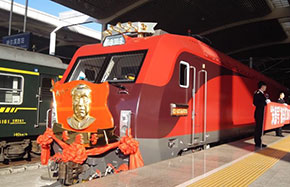Beijing takes lesson from fatal downpour
BEIJING - The beginning of the major flood season on Saturday has put Beijing authorities on high alert a year after the deadliest downpour in six decades killed 77 people.
The weather bureau has forecast torrential rain in the Chinese capital throughout the coming three weeks. The rains will be a rigorous test for the municipal government, which has been reinforcing the city's flood prevention infrastructure and early warning systems since last July's fatal downpour.
"We are making every effort to avoid injuries and drownings of people and vehicles during this year's rainy season," said Pan An'jun, spokesman for the city's flood prevention and drought relief headquarters.
The worst downpour to hit Beijing in six decades took heavy tolls, left vehicles submerged and flooded many homes on July 21, 2012, generating economic losses of about 11.6 billion yuan ($1.9 billion) in the process.
The chaos triggered public fury at the government's failure to properly respond to the deluge, and it prompted questions over the disparity between the city's faulty drainage system and its gleaming skyscrapers.
Over the past year, the government has been working to renovate overpasses, unclog sewers and dredge river channels -- all in a bid to improve the strained drainage system that was widely blamed for the urban waterlogging.
To date, workers have completed renovations on 20 overpasses under which floodwater rose to as much as 4 meters during last July's torrential rain, according to a statement the Beijing Water Authority wrote to Xinhua on Friday.
As part of the work, new pumping stations have been built alongside the bridges and existing facilities have been upgraded, thus expanding the pumping capacity from 30 cubic meters per second to 57 cubic meters per second, the statement said.
Nineteen ponds that can collectively hold 100,000 cubic meters of water have also been built near the overpasses to contain floodwater that can not be pumped away.
Twelve of the 20 renovated bridges are now able to withstand heavy downpours that are likely to fall once a decade, compared with previous standards of only two to three years, said the official.
Another 164 overpasses will be improved in the near future, he said.
During the July 21 rainstorm, a driver drowned after being trapped for three hours in his submerged SUV under the Guangqumen overpass in downtown Beijing.
Torrents of murky water that should have passed through a moat near the overpass swelled beyond the banks and inundated the street. The flood soon drowned the pumping house and all the draining pumps broke down.
"There were huge whirlpools in the moat. The river on that night was roaring like a gigantic black dragon," recalled Qu Ting, a woman who lives near Guangqumen and witnessed the driver's death last year.
The official said a new pumping station and a water storage pond have been set up near the Guangqumen overpass and will be put into operation next year.
To improve rivers' capability to discharge floodwater, the government has finished dredging 34 rivers, and work on more 1,460 kilometers of streams will start soon, according to Pan with the flood prevention headquarters.
Meanwhile, the Beijing Drainage Group has also stepped up efforts to clear the city's drainage tunnels that failed miserably during last July's disaster.
Ahead of this year's rainy season, the group dredged 2,061 km of sewers with newly-purchased and self-developed machines.
Before the sewers were unclogged, sediment and garbage had severely blocked the 1,300 km of drainage tunnels underneath Xicheng and Dongcheng districts in downtown Beijing, said Kuang Nuo, the group's assistant general manager.
Most of the pipes in Beijing's current drainage system were built half a century ago. The system was designed to withstand the test of only slight or moderate rainfalls that are likely to attack once every three years, "as the summer in Beijing is almost always dry," Pan explained.
However, it would be impossible to replace the outdated system with a modern one, according to Pan, who said that such a project would be "far too costly" and would "disrupt normal urban life."
"Therefore, we must focus on improving details and enhancing our ability to address emergencies," Pan said.
In response to criticism over the lack of early warnings ahead of last year's downpour, authorities began this year to warn citizens of potential rain disasters through text messages via mobile phones, as well as television and Internet broadcasts.
Beijing resident Jia Yue said she could feel the government's efforts to avoid similar tragedies in the future.
"I have received several text messages that warned of imminent rain this summer. That, I guess, is one of the lessons the government has drawn from the July 21 disaster," she said.
She suggested more work should be done to convince citizens that "there is no need to panic about a rainstorm," though the horrors of the flooding are still vivid memories for many.
Zhang Yue, an official with the Ministry of Housing and Urban-Rural Development, said legislation is indispensable in eliminating urban waterlogging, a matter that is largely neglected by the country's current flood control law.
The new law should require every city to formulate its own flood control plan and hold authorities accountable for fatal urban flooding, said Zhang, director of the ministry's urban water management bureau.
On Thursday, record rainfall for this year pounded Kunming, capital of southwest China's Yunnan Province. After the drainage system failed, flooding crippled the transportation network of the renowned tourist destination often called "the city of eternal spring."
Last week, the ministry ordered 36 large and medium-sized cities, including Kunming, to take measures to ensure that their urban centers would be safe even if the heaviest rains in 50 years were to fall.
Registration Number: 130349



























